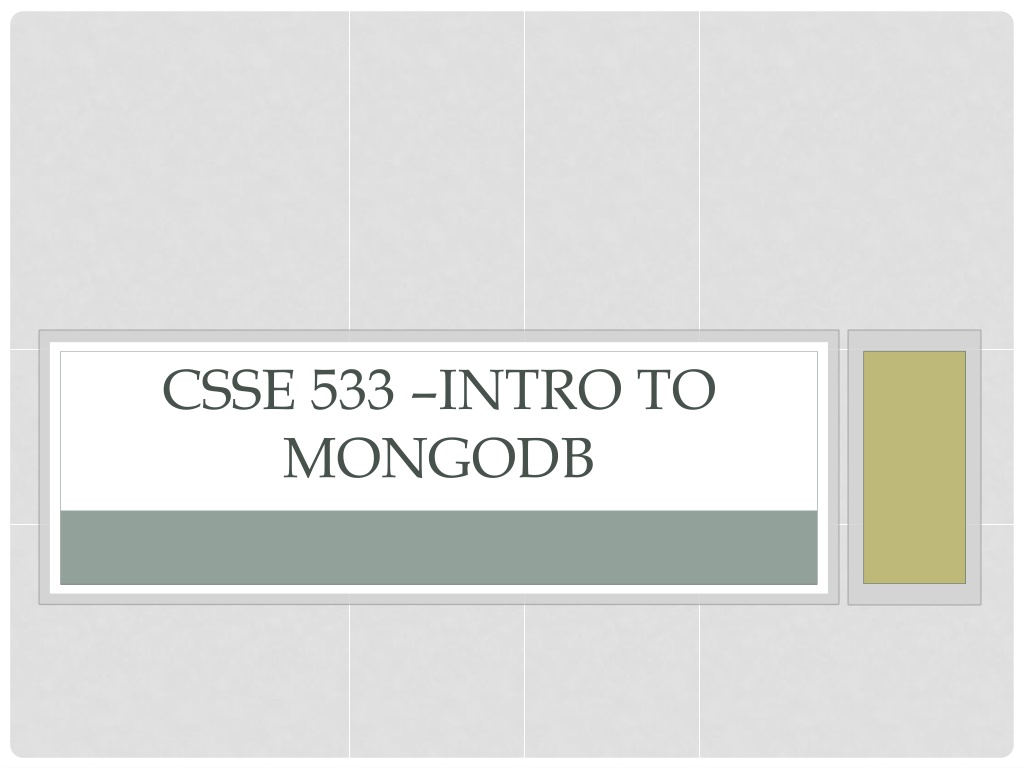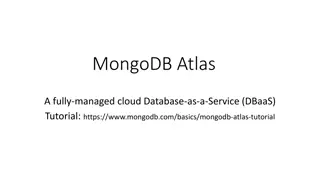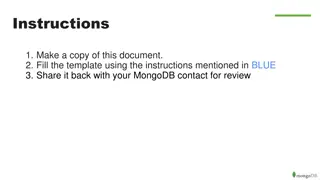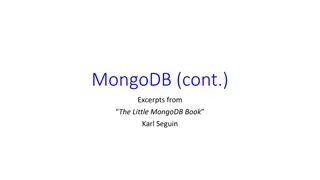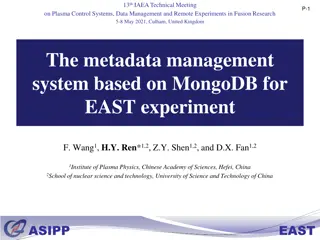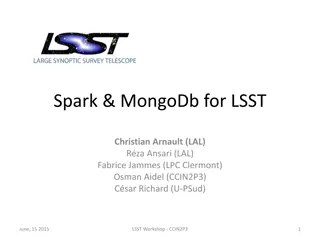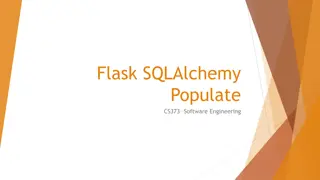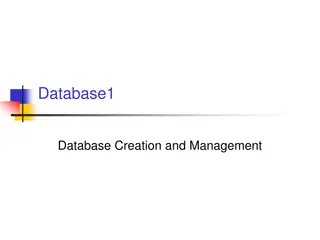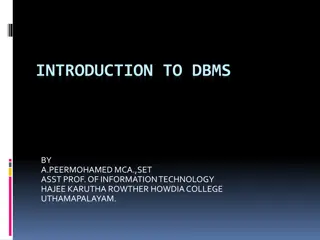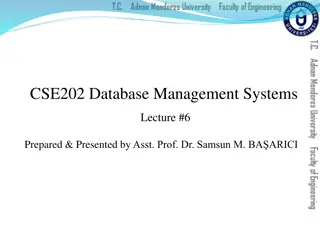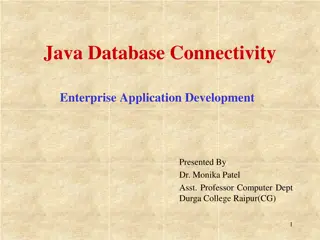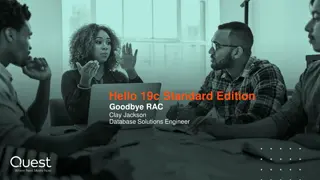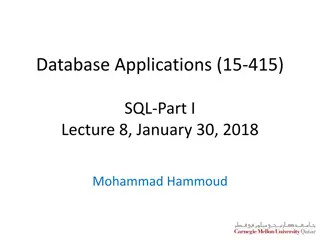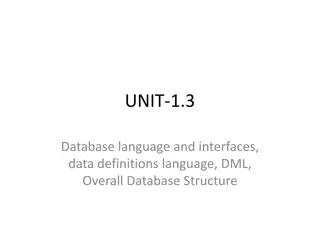Introduction to MongoDB: Document-Oriented Database Overview
MongoDB is a document-oriented database that uses JSON-like documents with dynamic schemas. Instead of SQL rows, MongoDB uses collections instead of tables and databases to organize data efficiently. The system is easy to start up and use, with a shell that acts as a JavaScript interpreter for CRUD operations. This introduction covers the basics of MongoDB, including collections, databases, and typical shell usage.
Uploaded on Sep 14, 2024 | 0 Views
Download Presentation

Please find below an Image/Link to download the presentation.
The content on the website is provided AS IS for your information and personal use only. It may not be sold, licensed, or shared on other websites without obtaining consent from the author. Download presentation by click this link. If you encounter any issues during the download, it is possible that the publisher has removed the file from their server.
E N D
Presentation Transcript
CSSE 533 INTRO TO WEEK 1, DAY 2 STEVE CHENOWETH CSSE DEPT MONGODB
THE ORIGINAL MONGO IN ACTION From Mel Brooks Blazing Saddles (1974) Played by former Detroit Lion Alex Karras. And he was humongous 2 2
DOCUMENTS INSTEAD OF SQL ROWS { greeting : Hello world } An ordered set of keys with values. Thus, fits in with how Hadoop works, for example! Most documents have multiple keys & values: { greeting : Hello world , foo : 3} The values can be lots of different types! But the keys are strings! With a few restrictions (see p 8) MongoDB is type and case sensitive. Can t duplicate keys in a single document. The ordering is important. This is BSON , like JSON . 3 3
COLLECTIONS INSTEAD OF TABLES With a dynamic schema. Different kinds of documents can go in a single collection. So why have multiple collections? (See p 9.) The name of a collection is also a valid string. You can make subcollections, like: blog.post But to MongoDB, these are all separate collections. To create a new collection, do something like: > db.createCollection("mycollection") 6 6
DATABASES Like in relational systems, A single instance of a DBMS can have many DB s in it. MongoDB databases also have string names. And a max of 64 bytes long. Databases also are used to save system stuff: admin is the root database. local puts things on a single server. config saves info about shards in a shared server setup. 7 7
HOW TO GET & STARTUP MONGODB pp 11-12 Widely considered to be easy . Comes with a shell (p 13): After starting mongoDB: $ mongo > It s a javascript interpreter. 8 8
TYPICAL SHELL USE Pick your db: > use foobar Pick your collection: > db.baz Do something to it, like CRUD: > post = { title : My Blog Post , content : Here s my blog post , date : new Date()} - at which point the shell repeats the data, filling in the date - Then, to insert it, > db.blog.insert(post) 9 9
MORE TYPICAL CRUD OPS > db.blog.find() or > db.blog.find(query) > db.blog.findOne() > db.blog.remove({title : My Blog Post }) > post.comments = [] > db.blog.update({title : My Blog Post }, post) Adds a key for comments to this document. More on querying in Ch 4 Lots more on this in Ch 3. 10 10
BASIC DATA TYPES All the JSON types, plus a few more: Null Boolean Number (floating or integer) String Date Regular expression Array Embedded document Object id every document has a 12-byte _id key. Unique within a collection. Binary data Code (arbitrary JavaScript) 11 11
EXAMPLES Arrays { things : [ pie , 3.14]) Embedded documents see slide 4 ObjectIds Created by the machine. The 12 bytes are: 0 1 2 3 | 4 5 6 | 7 8 | 9 10 11 Timestamp Machine PID Increment Created client-side with a document. 12 12
MORE ON THE SHELL Can connect to other mongod s Help includes typing functions to see how they work. (JavaScript) Can pass .js scripts to the shell. Shortcuts built-in, like: show collections - for db.getCollectionNames() Startup file .mongorc.js Customized prompts Can only edit current line! For more complex entries use an editor. 13 13
PRETTY GOOD WAYS TO START From Mohamed Zahran, NYU See Moodle Talks about how to get started with apps From Susan B. Davidson, Univ of Pennsylvania See Moodle Positions MongoDB in the DBMS panoply 14 14
ADDITIONAL INTERESTING INFO There are interfaces for using R with MongoDB! See, for example, http://cran.stat.ucla.edu/web/packages/rmongodb/READ ME.html http://cran.stat.ucla.edu/web/packages/rmongodb/vignet tes/rmongodb_introduction.html http://cran.stat.ucla.edu/web/packages/rmongodb/vignet tes/rmongodb_cheat_sheet.pdf 15 15
